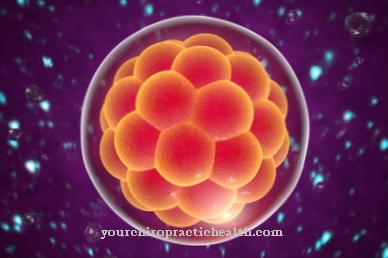The Body schema is the awareness of one's own body including its body-superficial delimitation from the environment. The concept is present from birth and therefore presumably genetic, but only develops fully after puberty. In addition to perceptual stimuli, language development also contributes to his training.
What is the body schema?

The body schema is a neuropsychological concept that describes the mental representation of one's own body and the orientation to it. The concept consists of two components: the imagination and the perception of the body. Although these two components can be distinguished from one another, they correlate strongly in a healthy person.
The awareness of the body and its limits has existed since birth. It is permanently confirmed anew through the multisensory information of the skin, movement and balance and is only fully developed through the repeated interaction of the individual with the environment. The body schema is the basis for the development of subjective individuality and self-worth. It is an important reference variable for all actions and reactions, although it is a rather unconscious variable.
Arnold Pick first described the main features in 1908. Pierre Bonnier described a disruption of the concept three years earlier under the term 'ashematia'.
The body schema is based on sensory and sensory stimuli of proprioception. The imaginary character of the body schema is, however, relatively independent of sensitive and sensory stimuli and thus not shaped by sharp object awareness. The body schema is therefore more of an idea than a perception. In addition to proprioception, social information, such as the naming of body parts, contribute to training.
Function & task
The body diagram is used for orientation in space. Since the body diagram separates one's own body from the environment, it is also the anchor point of subjective individuality and the starting point for self-esteem. The interaction between external perception and one's own body world is a field of tension in humans, which is described by the opposites of exteroception and interoception.
A body diagram is already in place at birth. This preverbal recognition process takes place through actions in both hemispheres and would be disturbed by lesions in both hemispheres. The preverbal body schema evolves with language development. In communication, the language-dominant hemisphere also becomes dominant for the body schema. The language-dominant hemisphere recognizes and communicates symbols on its own. From then on, she developed the body scheme, which remains as a fixed variable as a whole, for example even after the loss of an extremity. The cerebral, that is, the brain completed, integration performance is assumed to be a basic requirement for an intact body scheme. It is also known as the autotopic homunculus and is bound several times to the highest areas of the cerebral cortex.
Sensory-motor stimuli from the peripheral nervous system are projected and processed into the primarily sensitive cortical fields. They therefore correspond to a scaled-down model of peripheral body regions.
The integration and the coordination do not take place exclusively in the primary cortex, but in three different stages. In addition to the primary fields, tertiary association fields of the dominant half of the brain are involved in the process. In contrast to the integration, there is probably no structured somatotopic substrate for the body diagram. Rather, the body scheme seems to be based on a purely functional interplay of different non-topically structured brain fields. For this reason, the body scheme is disturbed, for example, even when tired. Because of the connections to the somatotopically segmented cortical field of the postcentral gyrus, at least a partially somatotopic structure is ascribed to the body feeling. A genetic basis of the scheme is suggested.
You can find your medication here
➔ Medicines for visual disturbances and eye complaintsIllnesses & ailments
The body schema can be distorted by mental disorders with impaired consciousness. It also plays a difficult role after amputations. If an amputated limb is not quickly replaced with prostheses, the patient often retains the old body diagram. You continue to perceive the amputated body parts and mentally move these phantom limbs with you. When children are missing limbs from birth, they sometimes still have the idea of the overall body diagram. This observation convinced scientists of a genetic basis for the body schema.
The well-known phantom pain after amputations have only a little to do with the body diagram. They correspond more to spontaneous excitations of the Noziz nerve cells, which were formerly assigned to the body part and form a so-called pain memory. The over-excitability of these nerve cells arises as a result of an operation trauma.
As after an amputation, the body structure is also disturbed in diseases in the dominant parietal region. Those affected no longer pay attention to the left half of the body. There is then a so-called neglect. The patient does not notice paralysis of the left extremities. This relationship is also known as anosognosia. Similarly, because of the body schema, there may be a neglect for blindness, as is the case with Anton syndrome.
Neuropsychological disorders of this kind are also underlying ego disorders. An example of such an ego disorder is depersonalization. There are localizing neuronal indications of a neurological representation of the psychological ego. So far, however, the ego could not be assigned to a specific brain center. Probably because it is too comprehensive and not yet properly understood by humans.
























.jpg)



